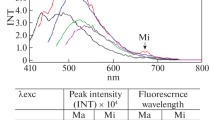Abstract
Black cumin (Nigella sativa L.) seeds and its essential oil have been widely used in functional foods, nutraceuticals and pharmaceutical products. Analysis of Nigella sativa essential oil using GC and GC-MS resulted in the identification of many bioactive compounds representing ca. 85 % of the total content. The main compounds included p-cymene, thymoquinone, α-thujene, longifolene, β-pinene, α-pinene and carvacrol. Nigella sativa essential oil exhibited different biological activities including antifungal, antibacterial and antioxidant potentials. Nigella sativa essential oil showed complete inhibition zones against different Gram-negative and Gram-positive bacteria including Penicillium citrinum Bacillus cereus, Bacillus subtilis, Staphylococcus aureus and Pseudomonas aeruginosa. The essential oil showed stronger antioxidant potential in comparison with synthetic antioxidants (i.e., BHA and BHT) in a rapeseed oil model system. The oil exhibited also stronger radical scavenging activity against DPPH·radical in comparison with synthetic antioxidants. The diversity of applications to which Nigella sativa essential oil can be put gives this oil industrial importance.




Similar content being viewed by others
References
Abdel-Wahhab MA, Aly SE (2005) Antioxidant property of Nigella sativa (black cumin) and Syzygium aromaticum (clove) in rats during aflatoxicosis. J Appl Toxicol 25:218–223
Ahmad A, Husain A, Mujeeb M, Khan SA, Najmi AK, Siddique NA, Damanhouri ZA, Anwar F (2013) A review on therapeutic potential of Nigella sativa: a miracle herb. Asian Pac J Trop Biomed 3:337–352
Ali BH, Blunden G (2003) Pharmacological and toxicological properties of Nigella sativa. Phytother Res 17:299–305
Alzoreky NS, Nakahara K (2003) Antimicrobial activity of extracts from some edible plants commonly consumed in Asia. Int J Food Microbiol 80:223–230
Bakkali F, Averbeck S, Averbeck D, Idaomar M (2008) Biological effects of essential oils e a review. Food Chem Toxicol 46:446–475
Benkaci–Ali F, Baaliouamer A, Meklati BY, Chemat F (2007) Chemical composition of seed essential oils from Algerian Nigella sativa extracted by microwave and hydrodistillation. Flavour Fragr J 22:148–153
Bourgou S, Pichette A, Marzouk B, Legault J (2010) Bioactivities of black cumin essential oil and its main terpenes from Tunisia. S Afr J Bot 76:210–216
Bourgou S, Pichette A, Lavoie S, Marzouk B, Legault J (2012) Terpenoids isolated from Tunisian Nigella sativa L. essential oil with antioxidant activity and the ability to inhibit nitric oxide production. Flavour Fragr J 27:69–74
Burits M, Bucar F (2000) Antioxidant activity of Nigella sativa essential oil. Phytother Res 14:323–328
Burt S (2004) Essential oils: their antibacterial properties and potential applications in foods-a review. Int J Food Microbiol 94:223–253
Butta MS, Sultana MT (2010) Nigella sativa: reduces the risk of various maladies. Crit Rev Food Sci Nutr 50:654–665
Cheikh-Rouhou S, Besbes S, Hentati B, Blecker C, Deroanne C, Attia H (2007) Nigella sativa L.: chemical composition and physicochemical characteristics of lipid fraction. Food Chem 101:673–681
D’Antuono LF, Moretti A, Lovato AFS (2002) Seed yield, yield components, oil content and essential oil content and composition of Nigella sativa L. and Nigella damascena L. Ind Crop Prod 15:59–69
Edris AE (2011) The chemical composition and the content of volatile oil: potential factors that can contribute to the oxidative stability of Nigella sativa L. crude oil. J Dietary Suppl 8:34–42
Eschborn MI (1997) Pruefung von Schwarzkuemmeloel. Pharm Ztg 142:46–48
Hajhashemi V, Ghannadi A, Jafarabadi H (2004) Black cumin seed essential oil, as a potent analgesic and anti-inflammatory drug. Phytother Res 18:195–199
Halawani E (2009) Antibacterial activity of thymoquinone and thymohydroquinone of Nigella sativa L. and their interaction with some antibiotics. Adv Biol Res 3:148–152
Hamrouni-Sellami I, Kchouk ME, Marzoul B (2008) Lipid and aroma composition of black cumin (Nigella sativa L.) Seeds from Tunisia. J Food Biochem 32:335–352
Harzallah HJ, Kouidhi B, Flamini G, Bakhrouf A, Mahjoub T (2011) Chemical composition, antimicrobial potential against cariogenic bacteria andvcytotoxic activity of Tunisian Nigella sativa essential oil and thymoquinone. Food Chem 129:1469–1474
Khosravi AR, Shokri H, Minooeianhaghighi M (2011) Inhibition of aflatoxin production and growth of Aspergillus parasiticus by Cuminum cyminum, Ziziphora clinopodioides, and Nigella sativa essential oils. Foodborne Pathog Dis 8:1275–1280
Lautenbacher LM (1997) Schwarzkuemmeloel. Dtsch Apoth Ztg 137:68–69
Mahgoub S, Ramadan MF, El-Zahar K (2013) Cold pressed Nigella sativa oil inhibits the growth of food-borne pathogens and improves the quality of Domiati cheese. J Food Saf 33:P470–P480
Nickavar B, Mojab F, Javinnia K, Amoli MAR (2003) Chemical composition of the fixed and volatile oils of Nigella sativa L. from Iran. Z Naturforsch 58:629–631
Ramadan MF (2007) Nutritional value, functional properties and nutraceutical applications of black cumin (Nigella sativa L.) oilseeds: an overview. Int J Food Sci Technol 42:1208–1218
Ramadan MF (2013) Healthy blends of high linoleic sunflower oil with selected cold pressed oils: functionality, stability and antioxidative characteristics. Ind Crops Prod 43:65–72
Salgueiro L, Martins AP, Correia H (2010) Raw materials: the importance of quality and safety. A review. Flavour Fragr J 25:253–271
Singh G, Marimuthu P, Heluani CS, Catalan C (2005) Chemical constituents and antimicrobial and antioxidant potentials of essential oil and acetone extract of Nigella sativa seeds. J Sci Food Agric 85:2297–2306
USFDA, U.S Food and Drug Administration (2006) Food additive status list. http://www.cfsan.fda.gov/%3Ddms/opa-appa.html#ftn.H Accessed 27 Nov 2012
Venkatachallam SKT, Pattekhan H, Divakar S, Kadimi US (2010) Chemical composition of Nigella sativa L. seed extracts obtained by supercritical carbon dioxide. J Food Sci Technol 47:598–605
Viuda-Marto M, Mohamady MA, Fernández-López J, Abd ElRazik KA, Omer EA, Pérez-Alvarez JA, Sendra E (2011) In vitro antioxidant and antibacterial activities of essentials oils obtained from Egyptian aromatic plants. Food Control 22:1715–1722
Wajs A, Bonikowski R, Kalemba D (2008) Composition of essential oil from seeds of Nigella sativa L. cultivated in Poland. Flavour Fragr J 23:126–132
Conflict of interest
None.
Compliance with ethics requirements
This article does not contain any studies with human or animal subjects.
Author information
Authors and Affiliations
Corresponding author
Rights and permissions
About this article
Cite this article
Hassanien, M.F.R., Assiri, A.M.A., Alzohairy, A.M. et al. Health-promoting value and food applications of black cumin essential oil: an overview. J Food Sci Technol 52, 6136–6142 (2015). https://doi.org/10.1007/s13197-015-1785-4
Revised:
Accepted:
Published:
Issue Date:
DOI: https://doi.org/10.1007/s13197-015-1785-4




